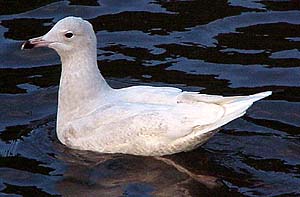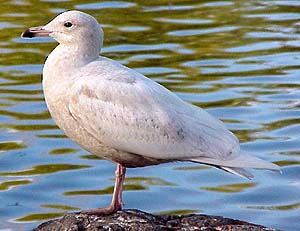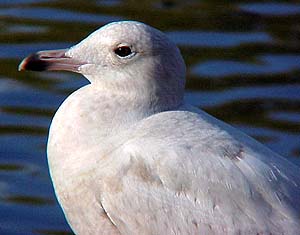

Photos © Stephen J. Davies
All rights reserved.


 |
 Photos © Stephen J. Davies All rights reserved. |
 |
 |
My opinion is that it is not a Glaucous Gull. I have never seen a definite Glaucous Gull which had so much dark bleeding into the lower mandible and extending any distance posterior to the gonys as shown by this bird. Furthermore, this bird shows a fairly dark belly contrasting with the pale upperparts. I believe a pure Glaucous Gull in April should not show so much dark below. The wings and tail are heavily worn, so the distinctive barring on the tail is not present.
If not Glaucous, what is it? The wing tips seem to extend beyond the tail by an amount equal to or less than the bill length, so I don't think Iceland is a likely candidate. Besides, I believe this bird was said to be an obvious large gull by observers in the field. A good candidate which I think might well fit this bird is "Nelson's Gull," a hybrid between Glaucous and Herring. Another possibility is a second winter Glaucous-winged Gull, which can have a bicolored bill as this bird. However, I think the bill shape is not very good for Glaucous-winged, which tends to have a bulkier tip, and the brownish belly argues against the idea that this is a second winter (third calendar year) bird.
A somewhat similar controversial gull was at Palo Alto last winter. Photos by Les Chibana are here. That bird was discussed extensively on the "South Bay Birders Online" email list. In my opinion the bird in those photos does not look like a pure Glaucous Gull.